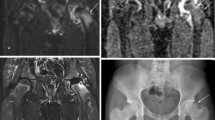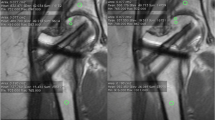Abstract
Background
A prognostic indicator of outcome for Legg-Calvé-Perthes disease (LCP) is needed to guide treatment decisions during the initial stage of the disease (stage 1), before deformity occurs. Radiographic prognosticators are applicable only after fragmentation (stage II).
Objective
We investigated pre- and postcontrast MRI in depicting stage I femoral head involvement.
Materials and methods
Thirty children with stage I LCP underwent non-contrast coronal T1 fast spin-echo (FSE) and corresponding postcontrast fat-suppressed T1-weighted fast spin-echo (FSE) sequences to quantify the extent of femoral head involvement. Three pediatric radiologists and one pediatric orthopedic surgeon independently measured central head involvement.
Results
Interobserver reliability of percent head involvement using non-contrasted MR images had intraclass correlation coefficient (ICC) of 0.72. Postcontrast MRI improved interobserver reliability (ICC 0.82). Qualitatively, the area of involvement was more clearly visible on contrast-enhanced MRI. A comparison of results obtained by each observer using the two MRI techniques showed no correlation. ICC ranged from −0.08 to 0.03 for each observer. Generally, greater head involvement was depicted by contrast compared with non-contrast MRI (Pearson r = −0.37, P = 0.04).
Conclusion
Pre- and postcontrast MRI assess two different components of stage I LCP. However, contrast-enhanced MRI more clearly depicts the area of involvement.





Similar content being viewed by others
References
Molloy MK, MacMahon B (1966) Incidence of Legg-Perthes disease (osteochondritis deformans). N Engl J Med 275:988–990
Kim HK, Herring JA (2011) Pathophysiology, classifications, and natural history of Perthes disease. Orthop Clin North Am 42:285–295
Catterall A (1981) The natural history of Perthes’ disease. J Bone Joint Surg Br 53:37–53
Catterall A (1981) Legg-Calve-Perthes syndrome. Clin Orthop Relat Res 158:41–52
Ritterbusch JF, Shantharam SS, Gelinas C (1993) Comparison of lateral pillar classification and Catterall classification of Legg-Calve-Perthes’ disease. J Pediatr Orthop 13:200–202
Herring JA, Kim HT, Browne R (2004) Legg-Calve-Perthes disease. Part I: classification of radiographs with use of the modified lateral pillar and Stulberg classifications. J Bone Joint Surg Am 86-A:2103–2120
Herring JA, Neustadt JB, Williams JJ et al (1992) The lateral pillar classification of Legg-Calve-Perthes disease. J Pediatr Orthop 12:143–150
Lappin K, Kealey D, Cosgrove A (2002) Herring classification: how useful is the initial radiograph? J Pediatr Orthop 22:479–482
Price CT (2007) The lateral pillar classification for Legg-Calve-Perthes disease. J Pediatr Orthop 27:592–593
Lamer S, Dorgeret S, Khairouni A et al (2002) Femoral head vascularisation in Legg-Calve-Perthes disease: comparison of dynamic gadolinium-enhanced subtraction MRI with bone scintigraphy. Pediatr Radiol 32:580–585
Kaniklides C, Lonnerholm T, Moberg A et al (1995) Legg-Calve-Perthes disease. Comparison of conventional radiography, MR imaging, bone scintigraphy and arthrography. Acta Radiol 36:434–439
Uno A, Hattori T, Noritake K et al (1995) Legg-Calve-Perthes disease in the evolutionary period: comparison of magnetic resonance imaging with bone scintigraphy. J Pediatr Orthop 15:362–367
Elsig JP, Exner GU, von Schulthess GK et al (1989) False-negative magnetic resonance imaging in early stage of Legg-Calve-Perthes disease. J Pediatr Orthop 9:231–235
Henderson RC, Renner JB, Sturdivant MC et al (1990) Evaluation of magnetic resonance imaging in Legg-Perthes disease: a prospective, blinded study. J Pediatr Orthop 10:289–297
Lahdes-Vasama T, Lamminen A, Merikanto J et al (1997) The value of MRI in early Perthes’ disease: an MRI study with a 2-year follow-up. Pediatr Radiol 27:517–522
Bos CF, Bloem JL, Bloem RM (1991) Sequential magnetic resonance imaging in Perthes’ disease. J Bone Joint Surg Br 73:219–224
Sebag G, Ducou Le Pointe H, Klein I et al (1997) Dynamic gadolinium-enhanced subtraction MR imaging–a simple technique for the early diagnosis of Legg-Calve-Perthes disease: preliminary results. Pediatr Radiol 27:216–220
Mahnken AH, Staatz G, Ihme N et al (2002) MR signal intensity characteristics in Legg-Calve-Perthes disease. Value of fat-suppressed (STIR) images and contrast-enhanced T1-weighted images. Acta Radiol 43:329–335
Waldenstrom H (1922) The definitive forms of coxa plana. Acta Radiol 1:384
Canale ST, D’Anca AF, Cotler JM et al (1972) Innominate osteotomy in Legg-Calve-Perthes disease. J Bone Joint Surg Am 54:25–40
Hochbergs P, Eckervall G, Wingstrand H et al (1997) Epiphyseal bone-marrow abnormalities and restitution in Legg-Calve-Perthes disease. Evaluation by MR imaging in 86 cases. Acta Radiol 38:855–862
Dillman JR, Hernandez RJ (2009) MRI of Legg-Calve-Perthes disease. AJR Am J Roentgenol 193:1394–1407
de Sanctis N, Rega AN, Rondinella F (2000) Prognostic evaluation of Legg-Calvé-Perthes disease by MRI. Part I: the role of physeal involvement. J Pediatr Orthop 20:455–462
de Sanctis N, Rondinella F (2000) Prognostic evaluation of Legg-Calvé-Perthes disease by MRI. Part II: pathomorphogenesis and new classification. J Pediatr Orthop 20:463–470
Jaramillo D, Kasser JR, Villegas-Medina OL et al (1995) Cartilaginous abnormalities and growth disturbances in Legg-Calvé-Perthes disease: evaluation with MR imaging. Radiology 197:767–773
Jaramillo D, Laor T, Zaleske DJ (1993) Indirect trauma to the growth plate: results of MR imaging after epiphyseal and metaphyseal injury in rabbits. Radiology 187:171–178
Eckerwall G, Hochbergs P, Simesen K et al (1997) Metaphyseal histology and magnetic resonance imaging in Legg-Calvé-Perthes disease. J Pediatr Orthop 17:659–662
Song HR, Dhar S, Na JB et al (2000) Classification of metaphyseal change with magnetic resonance imaging in Legg-Calvé-Perthes disease. J Pediatr Orthop 20:557–561
Tsuchida Y, Kim WC, Takahashi KA et al (2005) Usefulness of epiphyseal quotient measurement on magnetic resonance images for outcome prediction in patients with early stage Legg-Calve-Perthes disease. J Pediatr Orthop B 14:16–23
Merlini L, Combescure C, De Rosa V et al (2010) Diffusion-weighted imaging findings in Perthes disease with dynamic gadolinium-enhanced subtracted (DGS) MR correlation: a preliminary study. Pediatr Radiol 40:318–325
Winzenrieth R, Claude I, Hobatho MC et al (2006) Is there functional vascular information in anatomical MR sequences? A preliminary in vivo study. IEEE Trans Biomed Eng 53:1190–1196
Acknowledgments
The authors thank Dr. Richard Browne for statistical analysis, Lela Paksoy for administrative coordination of this project and Sandra Gaither for manuscript preparation. This work was supported in part by funding from Texas Scottish Rite Hospital for Children, St. Jude Children’s Research Hospital, American Lebanese Syrian Associated Charities and the International Perthes Study Group.
Conflicts of interest
None.
Author information
Authors and Affiliations
Corresponding author
Rights and permissions
About this article
Cite this article
Kim, H.K.W., Kaste, S., Dempsey, M. et al. A comparison of non-contrast and contrast-enhanced MRI in the initial stage of Legg-Calvé-Perthes disease. Pediatr Radiol 43, 1166–1173 (2013). https://doi.org/10.1007/s00247-013-2664-7
Received:
Revised:
Accepted:
Published:
Issue Date:
DOI: https://doi.org/10.1007/s00247-013-2664-7




